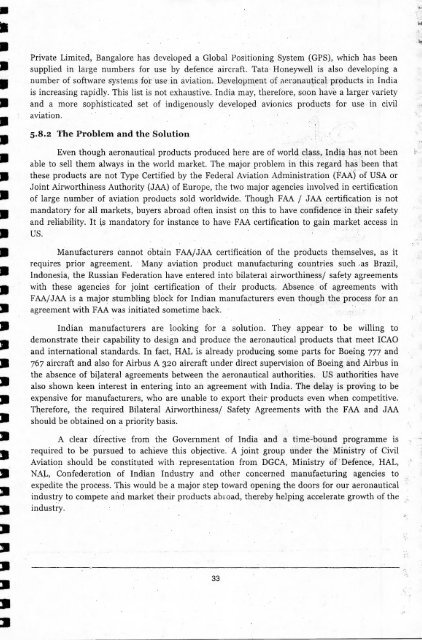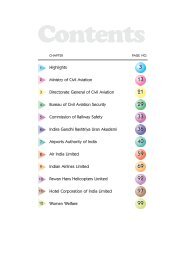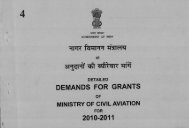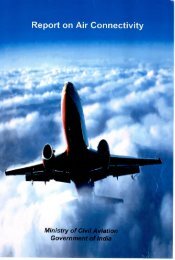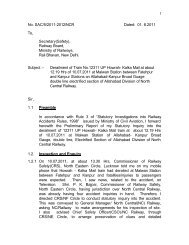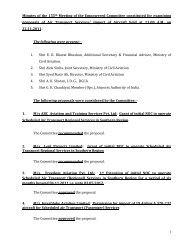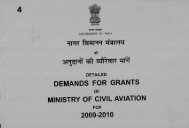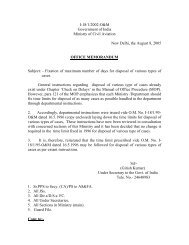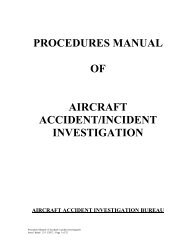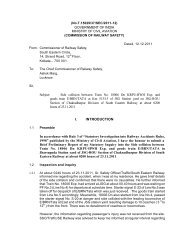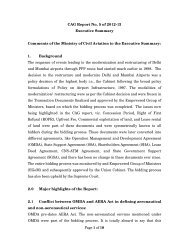3 - Ministry of Civil Aviation
3 - Ministry of Civil Aviation
3 - Ministry of Civil Aviation
You also want an ePaper? Increase the reach of your titles
YUMPU automatically turns print PDFs into web optimized ePapers that Google loves.
Private Limited, Bangalore has developed a Global Positioning System (GPS), which has beensupplied in large numbers for use by defence aircraft. Tata. Honeywell is also developing anumber <strong>of</strong> s<strong>of</strong>tware systems for use in aviation. Development <strong>of</strong> aeronautical products in Indiais increasing rapidly. This list is not exhaustive. India may, therefore, soon have a larger varietyand a more sophisticated set <strong>of</strong> indigenously developed avionics products for use in civilaviation.5.8.2 The Problem and the SolutionEven though aeronautical products produced here are <strong>of</strong> world class, India has not beenable to sell them always in the world market. The major problem in this regard has been thatthese products are not Type Certified by the Federal <strong>Aviation</strong> Administration (FAA) <strong>of</strong> USA orJoint Airworthiness Authority (JAA) <strong>of</strong> Europe, the two major agencies involved in certification<strong>of</strong> large number <strong>of</strong> aviation products sold worldwide. Though FAA / JAA certification is notmandatory for all markets, buyers abroad <strong>of</strong>ten insist on this to have confidence in their safetyand reliability. It is mandatory for instance to have FAA certification to gain market access inUS.Manufacturers cannot obtain FAA/JAA certification <strong>of</strong> the products themselves, as itrequires prior agreement. Many aviation product manufacturing countries such as Brazil,Indonesia, the Russian Federation have entered into bilateral airworthiness/ safety agreementswith these agencies for joint certification <strong>of</strong> their products. Absence <strong>of</strong> agreements withFAA/JAA is a major stumbling block for Indian manufacturers even though the process for anagreement with FAA was initiated sometime back.Indian manufacturers are looking for a solution. They appear to be willing todemonstrate their capability to design and produce the aeronautical products that meet ICAOand international standards. In fact, HAL is already producing some parts for Boeing 777 and767 aircraft and also for Airbus A 32o aircraft under direct supervision <strong>of</strong> Boeing and Airbus inthe absence <strong>of</strong> bilateral agreements between the aeronautical authorities. US authorities havealso shown keen interest in entering into an agreement with India. The delay is proving to beexpensive for manufacturers, who are unable to export their products even when competitive.Therefore, the required Bilateral Airworthiness/ Safety Agreements with the FAA and JAAshould be obtained on a priority basis.A clear directive from the Government <strong>of</strong> India and a time-bound programme isrequired to be pursued to achieve this objective. A joint group under the <strong>Ministry</strong> <strong>of</strong> <strong>Civil</strong><strong>Aviation</strong> should be constituted with representation from . DGCA, <strong>Ministry</strong> <strong>of</strong> Defence, HAL,NAL, Confederation <strong>of</strong> Indian Industry and other concerned manufacturing agencies toexpedite the process. This would be a major step toward opening the doors for our aeronauticalindustry to compete and market their products abioad, thereby helping accelerate growth <strong>of</strong> theindustry.33


